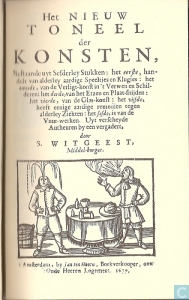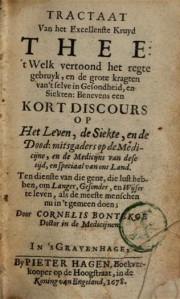In the spring of 2021, students of the Huizinga Institute, the Dutch national graduate school for cultural history, took part in the course “The Sensory Archive”. In this course, they read, transcribed, and prepared recipes from an eighteenth-century recipe manuscript from the University of Amsterdam’s special collections. Here, one student reflects on what he learned from cooking from historical recipes.
Guest post by Theo Dekker
Reconstructing both sister Hoffer’s recipe for lemon pie and a sugarloaf from the early eighteenth-century was an exciting experience, but it did not feel like conducting historical research. This feeling was strengthened when a fellow scholar asked me what I had learned, while at the same time she was enjoying my lemon pie. Since it took some time to formulate an answer, I realised two things: first, the learning outcomes were countless and second, that there was no single answer to this question. The latter made me uncomfortable since professional historical research should at least answer a question. The new director of the NWO, Marcel Levi, wrote something similar in April 2021, resembling a point stressed by Marieke Hendriksen using performative methods.[1] However, the proof of the pudding is in the eating, and cannot merely be determined behind a desk when reading (for example) recipe books. Only by performing the reconstruction itself, I learned how fruitful performative methods are. Therefore, I would like to share some of the perks and pitfalls that historians need to take into account when using performative methods, while at the same time you learn how to make and early modern lemon pie and sugarloaf.

Food historian Ken Albala claims that while reconstructing historical recipes, the technology ‘must be as authentic as possible to gain any really meaningful insights. Needless to say, the ingredients must be replicated exactly or the experiment is meaningless’.[2] Although it is evident that replicating the exact ingredients is impossible – fortunately – the aromas of for example wheat did not change significantly over time.[3] However, there were some technical difficulties that could be solved with sufficient resources, but in contrast to Albala, I am convinced that the meaning of the reconstruction lies in the questions that needs to be answered, not necessarily in the exact technology or the specific products. Therefore, in contrast to Albala, I would argue that historians should not restrict themselves, but be aware of the choices they make while using performative methods and be as transparent as possible about the implications that it has on the outcome.
One of the technical difficulties I encountered while making rosewater from the Damask rose was related the practice of distillation. Distilling alcohol for spirits, perfumes and aromas in general can be problematic. After the invention of column distillation in the late eighteenth century, the base of perfumes and aromas became rectified alcohol. As a result, the aromas of the original distilled product were lost, which was characteristic of early modern pot still distillation. Although it is possible to reconstruct early modern alcohol, it was too expensive for an educational exercise. As a result, the rosewater that I distilled for the sugarloaf in the seventeenth century distillery of Wynand Fockink, was too pure and concentrated compared to the original variant. Since it was used as an aroma for the loaf, the (grain) aromas of the alcohol itself would have been negligible, while for reconstructing a perfume it would have been necessary to make a proper reproduction.
While reconstructing the lemon pie I encountered two other problems. One concerned the measure of ‘1/2 stuijver of stale white bread’, and the other was the reference to the ‘crust’ in which the mixture needed to be poured in. To tackle the first problem, I used The Price of Bread (Cambridge, 2019) from Jan de Vries. In 1708 one-stuiver of ‘fine white bread’ weighted 15 loden, meaning that 1/2 stuiver bread weighted 165 grams, because 32 loden = 1 pound = 494 grams.[4] Three days before the reconstruction, I went to a former colleague who uses a self-made sourdough for the white bread and still bakes it on stone. Although the oven is powered by electricity, I tried to be as historically accurate as possible. Similar to the bread, there was no recipe in the cookbook for the ‘crust’ that it referred to. Therefore, I used recipe 26 Om wit deegh tot Pasteyen te maken from 1593 by Carolus Battus.
After blending the ingredients, the mixture was poured into a baking tray and placed in an electric oven, but with top and bottom heat. I set the temperature on 170 degrees Celsius based on the consistency of the mixture and the duration as described in the recipe. Slightly longer than in the original recipe, the lemon pie was coloured gold-brown after 105 minutes. The pie was still a bit fluid after it came out of the oven. But since it has to be served chilled and based on the combination of sugar and lemon juice, I expected a gelling effect after the pie cooled down. This was exactly what happened, and the next day I took it with me to the office so everybody there could evaluate the recipe. Most people were especially amazed by the texture and the freshness of the pie. The filling became gelatinous, but still had a slight bite to it because of the apples. Although one person said that the pie was somewhat sour, others said that it was well balanced and that it tasted healthy because I only added 100 grams of sugar.
Coming back to my original question of what I learned from these reconstructions is that an extraordinary amount of ‘know-how’ knowledge is already presupposed in the recipes. Since the practical knowledge cannot be obtained by only reading the recipes, it would be interesting to study this form of practical or embodied knowledge, which was common and significant to a large part of society. Several historians already set excellent examples for others to follow, but more comparative and cross-cultural research will provide new insights on the knowledge practices and identities of large groups in society.[5]
To conclude, performative methods are definitely here to stay as advocated by Marieke Hendriksen.[6] Nevertheless, the value and contribution of performative methods depends on their ability to answer scientific (historical) research questions. Similar to some digital humanities projects, tools and visualisations are created that look fancy but are barely useful in answering advanced research questions. Let’s not make similar mistakes with performative methods, by making empty promises or presenting humanistic scholarship as more ‘scientific’. Performative methods are of great value when they enrich our existing methodologies and enable us to answer new research questions. However, to come up with innovative research questions, academics should not restrict themselves to their desks, but get their hands dirty in kitchens, labs and bathrooms to be inspired by the creativity and the unexpected of the process itself. Furthermore, historians should continue discussing the methods and practices both within and outside the humanities. Not only to gain a better understanding of the past, but also to be informative and beneficial for both today and the future.

The recipes in Dutch and English.
Om citroentaart te maaken die kout op tafel moet koomen van Suster Hoffer.
4 a 5 suere appelen na dat groot sijn & geschilt op een rasp tot het klokhuijs toe afgeraspt, neemt dan 1/2 stuijver oudbakke wittebroot mede tot op de korst geraspt, dan 6 eijeren de helft sonder wit, ook 6 citroenen ’t buijtenste effen daar afgesraspt & dan het sap daar uijt gedrukt, doet dat te saamen onder de afgeraspte appelen, dan een lepel of vijf gesmolte booter & dan soo veel brootzuijker tot dat men proeft dat soet is, t’selve dan onder eij geklopt & in de korst gedaan laat een uer of anderhalf bakken.
To make lemon pie that should be served cold, by sister Hoffer
Take 4 to 5 sour apples depending on their size and grate them to their core on a rasp. The take a 1/2 stuijver of stale white bread also grated to the crust, 6 eggs of which half of the egg whites are removed and the grated peel and juice of 6 lemons. Mix this with the grated apples and add around 5 spoons of melted butter and as much sugar as is needed for it to taste sweet. Mix this with the eggs, pour it in a crust and let it bake for 1 to 1 1/2 hours.
Om zuijker broot te bakken.
2 pond blom, 2 pond beste poejer zuijker, 1 stuijver roose water 16 eijers fijn geklopt & dan de blom & zuijker daarin gestroit & het roose water daarbij gedaan & dit samen beslagen zijnde moet 1/2 uer uit geklopt worden & dat met een in het blik gegooten & in de oven geset.
To bake sugar-loaf
Take 2 pond of flour, 2 pond of the best powdered sugar, 1 stuijver of rose water, 16 well beaten eggs. Mix the flour and the sugar into the beaten eggs and add the rose water. When this is done it should be beaten for a 1/2 hour before it is poured into a tin and placed in the oven.
[1] Marieke Hendriksen, ‘Rethinking Performative Methods in the History of Science’, Berichte Zur Wissenschaftsgeschichte 43, nr. 3 (2020): 314, https://doi.org/10.1002/bewi.202000017.
[2] Ken Albala, ‘Cooking as Research Methodology: Experiments in Renaissance Cuisine’, z.d., 76.
[3] Friedrich Longin e.a., ‘Aroma and Quality of Breads Baked from Old and Modern Wheat Varieties and Their Prediction from Genomic and Flour-Based Metabolite Profiles’, Food Research International 129 (1 maart 2020): 108748, https://doi.org/10.1016/j.foodres.2019.108748.
[4] Jan de Vries, The Price of Bread: Regulating the Market in the Dutch Republic, Cambridge Studies in Economic History. Second Series (Cambridge: University Press, 2019), 232.
[5] Sara Pennell en Michelle DiMeo, Reading and Writing Recipe Books, 1550–1800 (Baltimore, Maryland: Project Muse, 2018); Elaine Yuen Tien Leong, Recipes and everyday knowledge: medicine, science, and the household in early modern England (Chicago ; London: The University of Chicago Press, 2018); M. Stols-Witlox, ‘“From Reading to Painting”: Authors and Audiences of Dutch Recipes for Preparatory Layers for Oil Painting’, Early Modern Low Countries 1, nr. 1 (2017): 71–134.
[6] Hendriksen, ‘Rethinking Performative Methods in the History of Science’, 321.

 I have tried to create an injected preparation in the past.
I have tried to create an injected preparation in the past.





You must be logged in to post a comment.